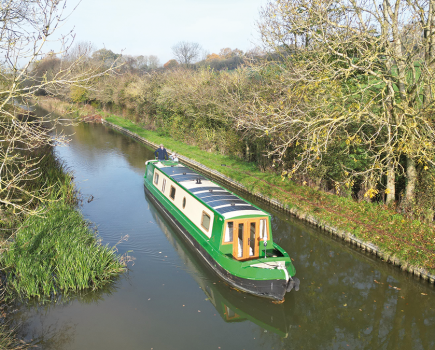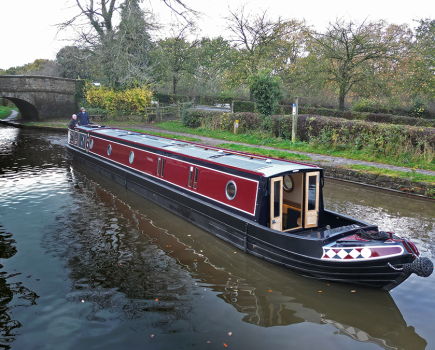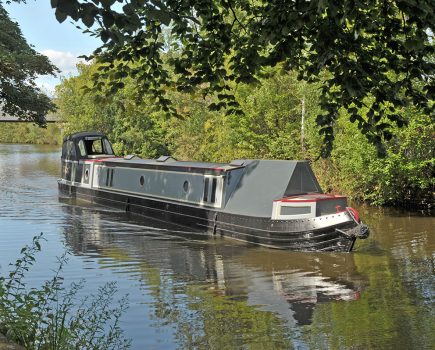What makes a boat truly stand out from the crowd? Sometimes you just need a little finesse

When it comes to what lifts a boat from being good to being great, the secret is often in the little things rather than the big ones – the details rather than the generalities. So let’s assume that the boat in question has a good quality shell and a decent fitout; what takes it to the next level can be the things that show real thought has been applied; the things that really meet the owners’ specific needs; the things that you might not necessarily have thought about. In short, a bit of finesse can make all the difference.
And that’s certainly true of this boat, which just happens to be built by Finesse Boats – the fitting out arm of the shell builders, Tyler Wilson. Here we have a boat which undoubtedly has a good shell, as it’s one of their own, and the fitout has a quality look and feel too. But when you look more closely there’s another layer of quality – lots of little touches that indicate a bit of design flair and real attention

EXTERIOR
Sonoma is based on a 60ft shell by Jonathan Wilson. Finesse has the exclusive rights to Jonathan’s boats – but don’t worry, other shells, branded Tyler Wilson or Mike Christian are still available. This just means that the shells used by Finesse are worked on by Jonathan himself at the firm’s boatyard in Sheffield.
And it’s clearly a very nice shell. There are recessed panels at the stern carrying sign writing by Andy Russell, scrolls in the handrails, and a boatman’s beam across the roof. There’s a lovely curvy Josher style bow, and this is one of the areas where Jonathan makes his mark. He insists that a Josher bow needs to be 10ft long to look really good; in many instances, this is shortened to 9ft, to give that little bit extra cabin space. But looking at it, you have to agree that Jonathan has a point: the extra long bow looks very elegant. And there are practical advantages too. Half of the extra foot goes into the well deck, making it a very large and useable space; the other half goes into the nose, and means you’ve got a decent amount of space to stand on when you need to get a gas bottle in or out of the locker (and anyone who’s had to balance on virtually nothing while carrying out this operation will know how tricky it can be).

The well deck itself has lockers both sides, and there are doors in the forward bulkhead giving access to the bow thruster tube. A stainless steel water tank is underneath.
There are more lockers, providing storage for mooring pins and suchlike either side of the semi-trad stern deck. The engine boards are another area where thought has been applied. Rather than the traditional wooden boards which can often be rather bulky, this boat has lockable metal covers. The forward half lifts up, while the other part can be slid forward for everyday access to the stern tube greaser, or removed completely.
There are taff seats at the stern. Jonathan Wilson refuses to fit them, believing they spoil the look of the boat and are also dangerous – you shouldn’t stand in the arc of the tiller to steer. They have to be fitted after the shell is finished, when he’s not looking. Personally, I’m on Jonathan’s side.

All the trim is in chrome, and the portholes are by Caldwells, but are only single glazed rather than double. Finesse says experience has shown that for portholes, which are relatively small in surface area, the difference in performance is modest. The roof has a satellite dish and an external internet antenna connected to a wifi router.
LAYOUT AND FITOUT

This is a reverse layout boat, with the galley at the stern. Moving forward, there’s a Pullman dinette and the saloon. The walk-through shower room comes next, with the cabin at the bow.
The fitout uses oak combined with painted ash panels on the cabin sides. These still have some texture, as the wood grain shows through the paint. The ceiling is also painted, and has been routed to look like tongue and groove. The floor is hard-wearing Karndean.
The quality of the joinery is one of the highlights of this boat. Everything is very well made and fits together perfectly.

GALLEY
We’ll start at the stern, where a set of curvy steps brings you down into the galley. They can be lifted out. There’s an electrical cupboard alongside, with the fuse panel and gauges. There’s also a small Dyson vacuum cleaner and a torch on charge.

The galley itself has smart black Quartz worktops. On one side there’s a stainless steel sink inset, with a drainer milled into the Quartz. This run of worktop also has a microwave at the end, with a cupboard above. There had been an inch of wasted space between the two, so the owners asked for an extra drawer – just a slim one where they could keep their knives. A shallow drawer was made and fitted, and is one of those little touches which this boat drips with. Another is the main cutlery drawer, specially made by Finesse, has shaped compartments for each utensil.
On the opposite side of the boat, there’s a four burner hob by CDA, with a full size Belling oven below. The fridge is a 240 volt model by Siemens, which has a freezer box. The unit at the end of the run is rather clever. There’s a door over the triangular part of the cupboard, then the whole unit pulls out to give access to what would otherwise be a dead corner. Opppsite, there’s a slim under-gunwale can cupboard.

DINETTE
The dinette is upholstered in striped fabric in a bright purple shade, a colour that reoccurs throughout the boat. It’s raised to make it easier to see out, and there are side doors both sides with glazed inner doors. The bench seats have drawers, and in one of them is a cool box for additional supplies of beer and soft drinks. The shallow drawer under the table is fitted with a wine rack. This drawer is also connected to another one behind, for longer term storage; pull it out completely, and the one behind comes with it.

There’s a double glazed pigeon box above the table for extra light, and it’s fitted with LED lights for night time. There’s also a fitted bung, to stop light coming in when the dinette is used as a guest bed.
The table itself is on Desmo legs. A nice decorative feature is an inlay of sapele wood, which lifts what might otherwise be a fairly standard table.

SALOON
The half height bulkhead between the dinette and the saloon has what’s probably this boat’s most decadent feature: a drinks cabinet. The front drops down on hydraulic dampeners, and has a black glass surface for mixing your drinks; fold back the top and an internal light comes on. There are shelves and cupboards below, plus a drop-forward magazine rack. The whole unit is very cleverly designed, and is a delight to look at (and, no doubt, use).
The TVs unit is an under gunwale affair, which has another sapele inlay. There’s more sapele inlaid into the trim at the very top of the cabin sides, giving a very polished look to the boat. A black tiled hearth carries a Lockgate Refleks diesel stove; the hearth has a lip in case of diesel spills. Other furniture includes a couple of captain’s chairs.

SHOWER ROOM
Purple makes a strong reappearance in the shower room, where it’s used on the walls, which are all lined with laminate. It takes quite a lot of belief to choose such a strong colour, but it really works.

There are under gunwale cupboards, which disappear as they have push catches rather than handles. The basin unit floats off the floor, and has a light underneath. Above is a slim wooden cupboard, which was supposed to have a mirror on the front; however, the owners liked the wood grain so much they decided to leave it as it was – and put a mirror on the back of the door instead.
The shower is a 900mm quadrant, lined with laminate. The loo is a SaniMarine macerator. The holding tank is across the boat at the stern. That’s quite a long way from the loo, and the connection is made using rigid pipework with a quoted lifespan of forty years.

CABIN
The in-line bed is 4ft wide, but pulls out to extend to 5ft. The base has drawers in the end, with long term storage behind. There’s plenty of storage space, with high level cupboards over the bed, and a good sized wardrobe one side of the bow doors with hanging space inside, and drawers underneath. On the opposite side there’s a curved corner unit with a mirror above. The steps are also curvy (there’s barely a square corner to be seen) and lift to give access to the water pump.

TECHNICAL
Sonoma is powered by a Beta 50 engine, which should provide more than enough power for a boat of this size. There’s also a Vetus 75kgf bow thruster, which works on a 24 volt system. In fact, the boat is 24 volt throughout; it’s more stable than 12 volts, and there’s less voltage drop through the cables. There are six 120Ah AGM batteries in the domestic bank. A 240 volt supply comes from a 5kw Victron inverter charger. Heating comes from a Webasto diesel boiler.
ON THE WATER
We’ve always liked the handling of Tyler Wilson boats, and this one is no exception. It’s very manoeuvrable, responding well to the tiller. Push the tiller over and apply a bit of power, and the nose immediately begins to turn. The engine is powerful yet still quiet enough. When you need a bit of help, perhaps against the wind when trying to get into a marina berth, the bow thruster gives plenty of grunt.
For the helmsman, the Morse control is conveniently placed on a column on the left hand side. The bow thruster control is on the front of the same column.
There’s plenty of room for crew on the semi-trad stern deck, and the lockers provide somewhere to sit. And there’s another of those above-and-beyond type features which make this boat stand out: there are flip-down glass holders on the stern doors, to make sure no wine gets spilled. The owners, Gordon and Dawn Scott say it’s a much safer place to put your drink. “In my experience, anything on the roof is likely to get knocked off,” says Gordon.
CONCLUSION
This is undoubtedly a high quality boat. The shell has lovely lines and a solid feel, while the fitout has all the hallmarks of excellence, with great joinery on show.
Of course this sort of quality costs money. But at around £150,000 it’s not an unreasonable price – in fact it’s what you’d expect to pay for a boat of this standard.
In many ways this is a fairly typical example of a Finesse boat – but it’s the little things that really make it stand out, from the sapele inlays to the glass holders, the cutlery drawer, and the beautifully designed drinks cabinet. They’re all non-standard features, which answer the customer’s needs, and show a bit of flair. Or, if you prefer, a bit of Finesse.
THE OWNERS
Gordon and Dawn Scott have been hiring boats for twenty-five years, and in that time has covered many of the southern canals and the Thames, as well as the Norfolk Broads and the French waterways.
Gordon has recently retired (early, he’s keen to point out!) after a forty year career selling components for trucks. The job took him around the world, but particularly the USA, Japan, and Brazil. Dawn is a teaching assistant at a primary school and enjoys the job so is keen to keep working for a while longer.
The couple are planning lots of long weekends as well as some longer trips, and have based the boat in Cheshire to help them explore waterways that are new to them. They had been looking at boats and builders for a couple of years before finally taking the plunge. Finesse was just getting started when they came to order their shell from Tyler Wilson, which is how they came to choose the fledgling firm as their fitters.
The name of the boat, Sonoma, comes from the couple’s favourite wine producing region, in California. It’s an Indian world meaning Valley of the Moon. They’ve holidayed there, and have just the odd bottle or two on board.
FINESSE BOATS
Finesse is pretty much the definition of a family firm, especially when you put it into the context of the whole Tyler Wilson business. Tim Tyler and Jonathan Wilson are brothers-in-law, and so are the main figures in Finesse, Ricky Lee and Louis Wilson. They’re the next generation of the family, as Louis is Jonathan’s son, and Ricky is married to Jonathan’s daughter.
Finesse is based in Sheffield, at the same yard where much of the steelwork is done. Louis continues to work on the shells, while Ricky brings skills from a previous life as an automotive engineer.
It was just over a year ago that we looked at the firm’s very first boat. Now there are two or three boats in build at any one time, at different stages of completion. The firm has a large joinery workshop which can accommodate three narrowboats or a narrowboat and a widebeam, and there’s also a state of the art paint shop. And the order book is looking healthy too, with at least the next year full up. Among the boats on order are three all-electric craft.
TECHNICAL SPECIFICATION
Finesse Boats, Victoria Boatyard, Sussex Street, Sheffield S4 7YY
07852 201375
sales@finesseboats.co.uk
Length: 60ft
Beam: 6ft 10in
Shell: Tyler Wilson www.tylerwilsonboats.com
Style: Semi-trad
Berths: 2+2
Fit-out: Oak and painted ash
Engine: Beta 50 Tel: 01452 723492 www.betamarine.co.uk
Inverter: Victron 5kw www.victronenergy.com
Bow Thruster: Vetus 75 kgf www.vetus.com
Lockgate Refleks stove: www.lockgate.com £650.00
Satellite dish: Oyster Cytrac DX www.oystersatellite.com £2,200
Flooring: Karndean www.karndean.com around £50 sqm
Total Price: £150,000
Image(s) provided by:
Archant







